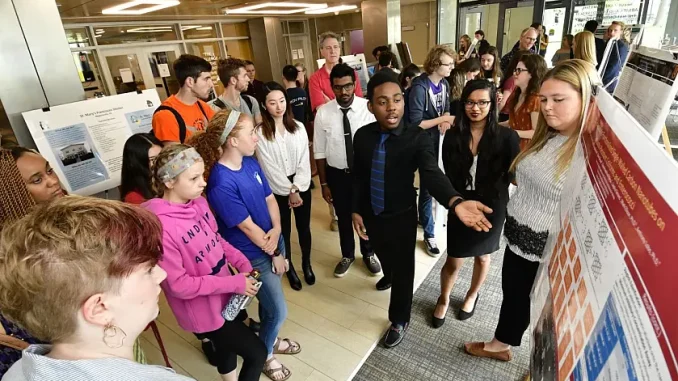
COSA, or the Celebration of Student Achievement, is a day when students are encouraged to attend presentations led by their peers instead of professors. Every year, class schedules are cleared for a full day so that students can attend presentations of interest without scheduling conflicts. Some teachers even actively encourage their students to attend certain presentations, promising worthwhile information or even extra credit in some cases for presentations they feel are particularly important to class materials. Additionally, many people go to support their friends and learn new and potentially valuable information about the fields they are pursuing. Some of the students presenting have been working on their presentations since the fall semester, dedicating months of their academic careers to their research, which will all culminate on this day. There are a variety of presentation types for people to view, including posters, talks, and performances that are all curated for the topic of research. The presentations fall on April 24th and go from 8:30am to 9:30pm, giving us a full day of student achievement and excellence to enjoy!
Though only a day long, COSA represents a complete dedication on the part of the presenter in terms of their time, knowledge, and determination to see the project through not just the semester, but the entire academic year. No presentation is without its hardships, as we all know as students, and COSA is no exception. When speaking to some students who were set to present, I learned that many of them–especially those in the physics and sciences departments–were worried about how much data they had and whether or not it was considered enough to be satisfactory.
Tyler Ways ‘24 and Annalyse Dickinson ‘25 of the Physics Department who presented “The Potential Utility of Elevation Profile Asymmetry in Classifying Lunar Craters” (Olin 102 10:33-10:50 a.m.), discussed how they worried that their information would not be digestible to people who had minimal knowledge about the topic. They also had reservations about whether their presentation was trimmed down enough to comply with the time limit.
Samantha Holden ‘24, Tyreek Mitchell ‘25, and Sierra Hufnagle ‘25, representing the Biology Department, presented a poster on the morphological and behavioral differences within the red-backed salamander species (Indoor Track 1-1:50p.m.). When asked about hardships her group faced, Holden discussed how the group worried that their data was not significant enough to discuss the results in a way that people would understand. She feared that people would not be interested due to the lack of a significant amount of data after running the experiment.
Antara Dabral ‘24, a Biology major, presented a poster on 23andme, posing the question of whether or not genetic analysis can detect a hereditary risk of hemochromatosis (Indoor Track 10-10:50am). Much like the previous presentations, they worried about being able to condense their data in a way that could be presented on a poster without overwhelming the audience or falling outside of their set time limit to present their research. These worries were not limited to STEM presentations, but plagued the minds of students in all departments.
Danielle Santana Denrich ‘24, a Psychology major presented her research on cults and cult dynamics (Indoor Track 10-10:50a.m.) and faced multiple obstacles while collecting her research over the course of more than a year. Many of these interruptions involved significant life events, setting her back a bit, but she continued on with her research no matter what life threw her way. By the end of it, her main concern was that there would not be enough time to discuss all she wanted to mention in her presentation.
COSA, though very important to students and faculty, is also a very stressful time for those who are presenting. They want their months (if not full year) of research to be remembered and appreciated in a way that makes people think about the content long after the presentation is finished. Despite all their hardships, the students were excited to present their projects to their peers. Perseverance always shines through during this event, reflected in the posters and voices of the students as they discuss their research to crowds of people.
